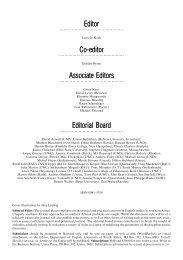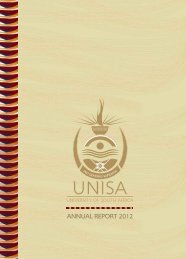pdf: 6.426kb - University of South Africa
pdf: 6.426kb - University of South Africa
pdf: 6.426kb - University of South Africa
You also want an ePaper? Increase the reach of your titles
YUMPU automatically turns print PDFs into web optimized ePapers that Google loves.
anthology, composed with as many different criteria<br />
as there were translators invited to collaborate ±<br />
would have required a more clarifying motivation for<br />
its composition, a more relevant explanation <strong>of</strong> the<br />
choices made by the translators. While only a minority<br />
allude to the literary qualities <strong>of</strong> the selected story,<br />
others simply limit themselves to the fact that the<br />
writer in question is important and deserves more<br />
attention from the public. Helen Lane submits her<br />
translation (<strong>of</strong> Luisa Valenzuela's `El lugar de su<br />
quietud') as an early example <strong>of</strong> her own translation<br />
style (p. 19). Asa Zatz, translator <strong>of</strong> Jorge Lanata's<br />
`Oculten la luna,' confides that the selection <strong>of</strong> this<br />
author `emerges in part from the pleasure <strong>of</strong> reading<br />
him' (p. 109). James Maraniss motivates his selection<br />
<strong>of</strong> `Incidente en la cordillera,' by Antonio BenJ1tez-<br />
Rojo, as follows: `I selected this story because I like it,<br />
had it at hand, was short enough for didactic use, and<br />
is the first piece that BenJ1tez-Rojo has written after<br />
thirteen years <strong>of</strong> non-fictional theorizing' (p. 163).<br />
The irrelevance <strong>of</strong> these comments becomes somewhat<br />
irritating when we examine the second important<br />
aspect <strong>of</strong> this book: the presentation <strong>of</strong> a series <strong>of</strong><br />
translations by eminent or promising experts. When,<br />
for example, an author who is known to be `difficult to<br />
translate,' like Dalton Trevisan, is selected by a<br />
translator as prominent as Gregory Rabassa, it would<br />
indeed be fascinating to learn about his style and<br />
method, about the problems and solutions he encountered.<br />
Instead, what strikes us is the triviality <strong>of</strong><br />
the observations some translators share with us: how<br />
late they work, whether they read the book once or<br />
twice, or which brand <strong>of</strong> ice cream helps them<br />
through moments <strong>of</strong> reduced inspiration. Responding<br />
to Stavans' questionnaire, some <strong>of</strong> them indicate that<br />
they prefer not to consult with the authors, and others<br />
say that they do; this does shed some light on the<br />
matter <strong>of</strong> a translator's style and method, but would it<br />
not have been more interesting to know what they<br />
consult them about?<br />
In spite <strong>of</strong> the hardly satisfactory result <strong>of</strong> the<br />
questionnaire, this book gives an interesting insight<br />
into the styles <strong>of</strong> different translators; after all, it is a<br />
bilingual edition. To give an example <strong>of</strong> a well<br />
motivated choice a translator can make: the character<br />
<strong>of</strong> Marco Denevi's story `Carta a Gianfranco' (translated<br />
by Alberto Manguel) makes a comment about<br />
the colour malva (mauve), and tells that she does not<br />
know what it looks like (p. 42). Obviously, this<br />
requires the English word for malva to be an<br />
uncommon one; therefore, I believe that `cerulean' is<br />
adequate. Further on in this same story, we read:<br />
`Ultramarinos. Que hermosa palabra, Gianfranco.<br />
Almace n de ultramarinos' (p. 52), which also for<br />
stylistic reasons leads to `Ultramarine shops' in<br />
English ± even though it might be less clear what<br />
these are.<br />
There is a similar stylistic problem in Jorge Turner's<br />
`Mangos de enero,' translated by Leland Chambers.<br />
One <strong>of</strong> the characters hears a `strange word: ``yearning''<br />
' (p. 253). Here the result <strong>of</strong> the translation is<br />
rather odd. Yearning is not such a strange word; but<br />
`desalmarse' is. Usually, difficulties <strong>of</strong> this kind also<br />
emerge from obligatory changes between Spanish<br />
and English, which <strong>of</strong>ten demand a creative solution.<br />
This could be the case, for instance, when there is an<br />
explicit reference to a change from the polite to the<br />
informal pronoun, or, as in the following example<br />
taken from `La mu sica de la lluvia' by Silvina Ocampo<br />
(translated by Suzanne Jill Levine): `± Para Octavito ±<br />
... ± No ± susurro la senÄ ora de Griber, detenie ndolo ±.<br />
Puede <strong>of</strong>enderlo. No le gustan los diminutivos'<br />
(p. 144), which becomes: ` ``For little Octavio'' ...<br />
``No,'' whispered Griber's mother, holding him back.<br />
``It may <strong>of</strong>fend him. He doesn't like diminutives.'' ' The<br />
solution sounds a little artificial, since the `diminutive'<br />
has disappeared from the translation.<br />
I agree that cena (`La cena' by Alfonso Reyes,<br />
translated by Rick Francis) could be translated into<br />
either `dinner' or `supper'; but why choose one for the<br />
title and the other for the quote that follows it (`The<br />
Dinner ± 'The supper, that delights and enchants. `±<br />
St. John <strong>of</strong> the Cross,' p. 5)? Why does the character<br />
<strong>of</strong> `La mu sica de la lluvia' put on `his shoes and his<br />
socks' (p. 145), and not, more conventionally, his<br />
socks first like his Spanish counterpart? I am not<br />
suggesting that these translations are wrong or<br />
inadequate; it is simply that the reader who feels<br />
encouraged by this bilingual version to compare both<br />
versions, is likely to be interested as well in the<br />
motivation for these choices. And again, he or she<br />
would have felt less frustrated if the introductions<br />
would have made a more serious reference to those<br />
questions.<br />
This review is not the place for an in-depth analysis<br />
<strong>of</strong> the translations presented in this book. But even a<br />
superficial glance at its pages leads to a disconcerting<br />
conclusion: the ones on the right are shorter than the<br />
ones on the left. The reason is that sometimes part <strong>of</strong> a<br />
sentence that appears in the original is missing from<br />
the translation. It also occurs that complete sentences<br />
or paragraphs have disappeared. I found fragments<br />
that I could not trace in the English versions on pages<br />
26, 28, 30, 32, 34 (`El lugar de su quietud'), 144 (`La<br />
mu sica de la lluvia'), 284, 292 (Felisberto Herna ndez,<br />
`El cocodrilo,' translated by Alfred MacAdam) and<br />
322 (Jose Carmona Blanco, `Los camalotes,' translated<br />
by Toby Talbot). This is probably an editing<br />
problem, since I also came across translations <strong>of</strong><br />
fragments that were missing from the Spanish texts,<br />
on pages 65 (`Carta a Gianfranco') and 311 (`Los<br />
camalotes'). 2<br />
A remarkable translating style attracts the attention<br />
to Donald Yates' version <strong>of</strong> `Cotode caza,' by Ruben<br />
ISSN 0256±6060±Unisa Lat. Am. Rep. 16(2) 2000 87

















